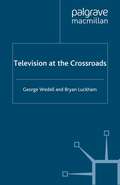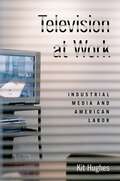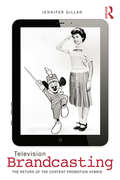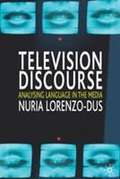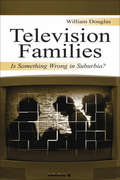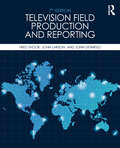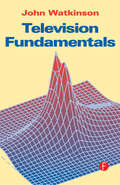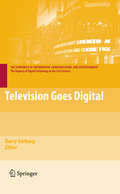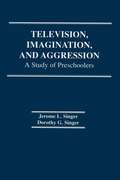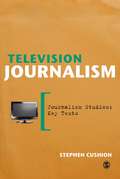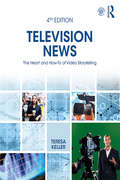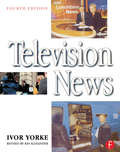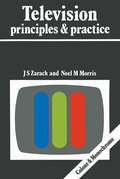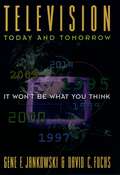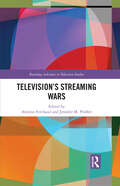- Table View
- List View
Television at the Crossroads
by G. Wedell B. LuckhamTelevision had, until recently, a social and cultural purpose. The BBC, and to a lesser extent ITV and Channel 4, were committed by the legal instruments establishing them to develop and maintain these purposes. With the enlargement of the range of choices for viewers by digital television and the provision of access to cable and satellite TV and the Internet, the role of the terrestrial television channels is being diluted. The authors examine the effects of this and consider whether anything can be done to maintain the standards and quality of television at a time of unlimited competition.
Television at Work: Industrial Media and American Labor
by Kit HughesTelevision has never been exclusive to the home. In Television at Work, Kit Hughes explores the forgotten history of how U.S. workplaces used television to secure industrial efficiency, support corporate expansion, and manage the hearts, minds, and bodies of twentieth century workers. Challenging our longest-held understandings of the medium, Hughes positions television at the heart of a post-Fordist reconfiguration of the American workplace revolving around dehumanized technological systems. Among other things, business and industry built private television networks to distribute programming, created complex CCTV data retrieval systems, encouraged the use of videotape for worker self-evaluation, used video cassettes for training distributed workforces, and wired cantinas for employee entertainment. In uncovering industrial television as a prolific sphere of media practice, Television at Work reveals how labor arrangements and information architectures shaped by these uses of television were foundational to the rise of the digitally mediated corporation and to a globalizing economy.
TELEVISION AT WORK C: Industrial Media and American Labor
by Kit HughesTelevision has never been exclusive to the home. In Television at Work, Kit Hughes explores the forgotten history of how U.S. workplaces used television to secure industrial efficiency, support corporate expansion, and manage the hearts, minds, and bodies of twentieth century workers. Challenging our longest-held understandings of the medium, Hughes positions television at the heart of a post-Fordist reconfiguration of the American workplace revolving around dehumanized technological systems. Among other things, business and industry built private television networks to distribute programming, created complex CCTV data retrieval systems, encouraged the use of videotape for worker self-evaluation, used video cassettes for training distributed workforces, and wired cantinas for employee entertainment. In uncovering industrial television as a prolific sphere of media practice, Television at Work reveals how labor arrangements and information architectures shaped by these uses of television were foundational to the rise of the digitally mediated corporation and to a globalizing economy.
Television Brandcasting: The Return of the Content-Promotion Hybrid
by Jennifer GillanTelevision Brandcasting examines U. S. television’s utility as a medium for branded storytelling. It investigates the current and historical role that television content, promotion, and hybrids of the two have played in disseminating brand messaging and influencing consumer decision-making. Juxtaposing the current period of transition with that of the 1950s-1960s, Jennifer Gillan outlines how in each era new technologies unsettled entrenched business models, an emergent viewing platform threatened to undermine an established one, and content providers worried over the behavior of once-dependable audiences. The anxieties led to storytelling, promotion, and advertising experiments, including the Disneyland series, embedded rock music videos in Ozzie & Harriet, credit sequence brand integration, Modern Family’s parent company promotion episodes, second screen initiatives, and social TV experiments. Offering contemporary and classic examples from the American Broadcasting Company, Disney Channel, ABC Family, and Showtime, alongside series such as Bewitched, Leave it to Beaver, Laverne & Shirley, and Pretty Little Liars, individual chapters focus on brandcasting at the level of the television series, network schedule, "Blu-ray/DVD/Digital" combo pack, the promotional short, the cause marketing campaign, and across social media. In this follow-up to her successful previous book, Television and New Media: Must-Click TV, Gillan provides vital insights into television’s role in the expansion of a brand-centric U.S. culture.
Television Brandcasting: The Return of the Content-Promotion Hybrid
by Jennifer GillanTelevision Brandcasting examines U. S. television’s utility as a medium for branded storytelling. It investigates the current and historical role that television content, promotion, and hybrids of the two have played in disseminating brand messaging and influencing consumer decision-making. Juxtaposing the current period of transition with that of the 1950s-1960s, Jennifer Gillan outlines how in each era new technologies unsettled entrenched business models, an emergent viewing platform threatened to undermine an established one, and content providers worried over the behavior of once-dependable audiences. The anxieties led to storytelling, promotion, and advertising experiments, including the Disneyland series, embedded rock music videos in Ozzie & Harriet, credit sequence brand integration, Modern Family’s parent company promotion episodes, second screen initiatives, and social TV experiments. Offering contemporary and classic examples from the American Broadcasting Company, Disney Channel, ABC Family, and Showtime, alongside series such as Bewitched, Leave it to Beaver, Laverne & Shirley, and Pretty Little Liars, individual chapters focus on brandcasting at the level of the television series, network schedule, "Blu-ray/DVD/Digital" combo pack, the promotional short, the cause marketing campaign, and across social media. In this follow-up to her successful previous book, Television and New Media: Must-Click TV, Gillan provides vital insights into television’s role in the expansion of a brand-centric U.S. culture.
Television Discourse: Analysing Language In The Media (PDF)
by Nuria Lorenzo-DusWhat is the connection between what is said on TV and how it is said? Structured around key features of television discourse, Nuria Lorenzo-Dus examines the specific forms and structures of talk across media genres. Using data from programs as varied as news bulletins and political speeches to makeover and talk shows,Television Discourse examines four defining characteristics of the current broadcast landscape: Storytelling, Closeness, Conflict and Persuasion. This innovative, four-part structure allows for detailed discourse analysis of how each feature works in context; whilst 'Storytelling' is examined in relation to docu-soaps and talk shows, 'Closeness' is explored through the mediums of celebrity chat shows and reality programming. Insightful analysis of 'Conflict' in courtroom shows and 'Persuasion' in lifestyle programs enables readers to think critically about the ways in which television discourse is used to influence the viewer. With a helpful glossary and extensive guide to further reading,Television Discourse is an invaluable resource for all those interested in studying language in the media.
Television Families: Is Something Wrong in Suburbia? (Routledge Communication Series)
by William DouglasThis volume examines the analysis that was designed to map the development of the television family and assess its current state and, at the same time, to provide insight into the tangled relationships between fictional and real family life. In order to do this, the investigation examines the evolution of the American family, paying special attention to the postwar family, which is not only used recurrently as a benchmark for assessing the performance of modern families but also constituted television's first generation of families. The investigation also traces the evolution of the popular family in vaudeville, comics, and radio. However, the primary focus of the examination is the development of the television family, from families, such as the Nelsons, Andersons, and Cleavers, to more contemporary families, such as the Huxtables, Conners, and Taylors. The unit of analysis for the investigation is the relationship rather than the individual. Hence, the book deals with the portrayal of spousal, parent-child, and sibling relationships and how those portrayals differ across time and across groups defined by ethnicity, gender, and age. Moreover, the relational analysis is expansive so that television family relationships are examined in regard to power and affect, performance, and satisfaction and stability. Television Families provides a thorough summary and critical review of extant research, designed to promote informed classroom discussion. At the same time, it advances a number of hypotheses and recommendations and, as such, is intended to influence subsequent theory and research in the area. The book is intended for senior undergraduate students, graduate students, and television and family researchers.
Television Families: Is Something Wrong in Suburbia? (Routledge Communication Series)
by William DouglasThis volume examines the analysis that was designed to map the development of the television family and assess its current state and, at the same time, to provide insight into the tangled relationships between fictional and real family life. In order to do this, the investigation examines the evolution of the American family, paying special attention to the postwar family, which is not only used recurrently as a benchmark for assessing the performance of modern families but also constituted television's first generation of families. The investigation also traces the evolution of the popular family in vaudeville, comics, and radio. However, the primary focus of the examination is the development of the television family, from families, such as the Nelsons, Andersons, and Cleavers, to more contemporary families, such as the Huxtables, Conners, and Taylors. The unit of analysis for the investigation is the relationship rather than the individual. Hence, the book deals with the portrayal of spousal, parent-child, and sibling relationships and how those portrayals differ across time and across groups defined by ethnicity, gender, and age. Moreover, the relational analysis is expansive so that television family relationships are examined in regard to power and affect, performance, and satisfaction and stability. Television Families provides a thorough summary and critical review of extant research, designed to promote informed classroom discussion. At the same time, it advances a number of hypotheses and recommendations and, as such, is intended to influence subsequent theory and research in the area. The book is intended for senior undergraduate students, graduate students, and television and family researchers.
Television Field Production and Reporting: A Guide to Visual Storytelling
by Fred Shook John Larson John DeTarsioTelevision Field Production and Reporting provides a comprehensive introduction to the art of video storytelling. Endorsed by the National Press Photographers Association, this book focuses on the many techniques and tools available in today’s digital landscape, including how drones and miniaturized technology can enrich the storytelling process. The new edition of Television Field Production and Reporting is an absolute must in this visually oriented, rapidly changing field. At its core, visual storytelling helps transmit information, expose people to one another, and capture and communicate a sense of experience in unforgettable ways. This edition reflects, through practitioners' eyes, how to achieve those goals and excel as a professional, whatever the medium at hand, even as changing technology revises the storyteller’s toolkit. This edition emphasizes digital and emerging media, and includes new color photography relevant to contemporary visual storytelling and reporting. It also features important updates regarding digital media law which affect anyone who records and/or disseminates digital media content, whether in private, on television, the web, via social networking sites, or in commercial venues. The seventh edition of Television Field Production and Reporting stresses the mastery of innovative storytelling practices in video programming as far ranging as electronic press kits, multi-camera production, stylized programs, corporate video, raw documentaries, and real time cinéma vérité.
Television Field Production and Reporting: A Guide to Visual Storytelling
by Fred Shook John Larson John DeTarsioTelevision Field Production and Reporting provides a comprehensive introduction to the art of video storytelling. Endorsed by the National Press Photographers Association, this book focuses on the many techniques and tools available in today’s digital landscape, including how drones and miniaturized technology can enrich the storytelling process. The new edition of Television Field Production and Reporting is an absolute must in this visually oriented, rapidly changing field. At its core, visual storytelling helps transmit information, expose people to one another, and capture and communicate a sense of experience in unforgettable ways. This edition reflects, through practitioners' eyes, how to achieve those goals and excel as a professional, whatever the medium at hand, even as changing technology revises the storyteller’s toolkit. This edition emphasizes digital and emerging media, and includes new color photography relevant to contemporary visual storytelling and reporting. It also features important updates regarding digital media law which affect anyone who records and/or disseminates digital media content, whether in private, on television, the web, via social networking sites, or in commercial venues. The seventh edition of Television Field Production and Reporting stresses the mastery of innovative storytelling practices in video programming as far ranging as electronic press kits, multi-camera production, stylized programs, corporate video, raw documentaries, and real time cinéma vérité.
Television Fundamentals
by John WatkinsonTelevision today means moving pictures in colour with sound, brought to the viewer by terrestrial or satellite broadcast, cable or recording medium. The technique and processes necessary to create, record, deliver and display television pictures form the major part of this book. Television Fundamentals is written in clear English, with a minimum of mathematics. Readers are taken, in a logical sequence of small steps, through the fundamental principles of the subject, with practical applications and a guide to troubleshooting included. Encoding, decoding, recording and transmission are treated in depth.John Watkinson is an independent consultant in digital video, audio and data technology. He is a Fellow of the AES and presents lectures, conference papers and training courses worldwide. he is the author of numerous other Focal Press books, including: Compression in Video and Audio, The Art of Digital Audio and The Art of Digital Video (now in their second editions), the Art of Data Recording, An Introduction to Digital Audio, An Introduction to Digital Video, The Digital Video Tape Recorder and RDAT.
Television Fundamentals
by John WatkinsonTelevision today means moving pictures in colour with sound, brought to the viewer by terrestrial or satellite broadcast, cable or recording medium. The technique and processes necessary to create, record, deliver and display television pictures form the major part of this book. Television Fundamentals is written in clear English, with a minimum of mathematics. Readers are taken, in a logical sequence of small steps, through the fundamental principles of the subject, with practical applications and a guide to troubleshooting included. Encoding, decoding, recording and transmission are treated in depth.John Watkinson is an independent consultant in digital video, audio and data technology. He is a Fellow of the AES and presents lectures, conference papers and training courses worldwide. he is the author of numerous other Focal Press books, including: Compression in Video and Audio, The Art of Digital Audio and The Art of Digital Video (now in their second editions), the Art of Data Recording, An Introduction to Digital Audio, An Introduction to Digital Video, The Digital Video Tape Recorder and RDAT.
Television Goes Digital (The Economics of Information, Communication, and Entertainment)
by Darcy GerbargTelevision has become a ubiquitous part of our lives, and yet its impact continues to evolve at an extraordinary pace. The evolution of television from analog to digital technology has been underway for more than half a century. Today's digital technology is enabling a myriad of new entertainment possibilities. From jumbotrons in cyberspace to multi-dimensional viewing experiences, digital technology is changing television. Consequently, new advertising metrics that reflect the new viewer habits are emerging. The ability to capture a viewer's interactions changes the advertising proposition. Telephone and wireless companies are challenging the traditional mass media providers - broadcasters, cable and satellite companies - and they’re all finding ways to deliver TV programming, video content and Internet offerings to large and small screens in the home and on the go. This volume showcases insights from industry insiders and researchers from a variety of disciplines. It explores the economic, cultural, technical, and policy implications of digital television, addressing such questions as: How will content be monetized in the future? What programming opportunities become possible with the advent of going digital? Will content still be king or will the conduits gain the upper hand? This book analyzes the digital television evolution: its impacts on the economics of the TV industry, its significance for content creation from Hollywood blockbusters to You Tube, the changing role of the consumer, and what's coming next to a theatre near you.
Television, Imagination, and Aggression: A Study of Preschoolers
by D. G. SingerFirst Published in 1981. Routledge is an imprint of Taylor & Francis, an informa company.
Television, Imagination, and Aggression: A Study of Preschoolers
by D. G. SingerFirst Published in 1981. Routledge is an imprint of Taylor & Francis, an informa company.
Television Journalism
by Stephen Cushion"Amidst the glut of studies on new media and the news, the enduring medium of television finally gets the attention it deserves. Cushion brings television news back into perfect focus in a book that offers historical depth, geographical breadth, empirical analysis and above all, political significance. Through an interrogation of the dynamics of and relations between regulation, ownership, the working practices of journalism and the news audience, Cushion makes a clear case for why and how television news should be firmly positioned in the public interest. It should be required reading for anyone concerned with news and journalism." - Natalie Fenton, Goldsmiths, University of London "An admirably ambitious synthesis of journalism scholarship and journalism practice, providing a comprehensive resource of historical analysis, contemporary trends and key data." - Stewart Purvis, City University and former CEO of ITN Despite the democratic promise of new media, television journalism remains the most viewed, valued and trusted source of information in many countries around the world. Comparing patterns of ownership, policy and regulation, this book explores how different environments have historically shaped contemporary trends in television journalism internationally. Informed by original research, Television Journalism lays bare the implications of market forces, public service interventions and regulatory shifts in television journalism's changing production practices, news values and audience expectations. Accessibly written and packed with topical references, this authoritative account offers fresh insights into the past, present and future of journalism, making it a necessary point of reference for upper-level undergraduates, researchers and academics in broadcasting, journalism, mass communication and media studies.
Television Journalism
by Stephen Cushion"Amidst the glut of studies on new media and the news, the enduring medium of television finally gets the attention it deserves. Cushion brings television news back into perfect focus in a book that offers historical depth, geographical breadth, empirical analysis and above all, political significance. Through an interrogation of the dynamics of and relations between regulation, ownership, the working practices of journalism and the news audience, Cushion makes a clear case for why and how television news should be firmly positioned in the public interest. It should be required reading for anyone concerned with news and journalism." - Natalie Fenton, Goldsmiths, University of London "An admirably ambitious synthesis of journalism scholarship and journalism practice, providing a comprehensive resource of historical analysis, contemporary trends and key data." - Stewart Purvis, City University and former CEO of ITN Despite the democratic promise of new media, television journalism remains the most viewed, valued and trusted source of information in many countries around the world. Comparing patterns of ownership, policy and regulation, this book explores how different environments have historically shaped contemporary trends in television journalism internationally. Informed by original research, Television Journalism lays bare the implications of market forces, public service interventions and regulatory shifts in television journalism's changing production practices, news values and audience expectations. Accessibly written and packed with topical references, this authoritative account offers fresh insights into the past, present and future of journalism, making it a necessary point of reference for upper-level undergraduates, researchers and academics in broadcasting, journalism, mass communication and media studies.
Television News: The Heart and How-To of Video Storytelling
by Teresa KellerTelevision News is a comprehensive resource for newswriting, reporting, shooting and editing video, and producing a newscast. This book provides instruction in the basic steps of telling video stories, and is perfectly suited for preparing young professionals for entry-level positions as television or multimedia journalists. Moreover, the text goes to the heart of storytelling with guidance appropriate for advancement in an industry that is challenged more than ever to retain the public trust. The reporting and video storytelling skills found in this book can also be applied in non-traditional video communication jobs in both businesses and nonprofits. Conversational and easy to understand, this book grounds readers in the ethical and legal consideration necessary to do the job right. New to the fourth edition is coverage of social media, shooting and broadcasting with cell phones, and a discussion of “fake news.” This book can be used in standalone introductory broadcast courses or across multiple, specialized modules. It features a website with ancillary material that helps students learn to write, shoot, and edit video with practical activities.
Television News: The Heart and How-To of Video Storytelling
by Teresa KellerTelevision News is a comprehensive resource for newswriting, reporting, shooting and editing video, and producing a newscast. This book provides instruction in the basic steps of telling video stories, and is perfectly suited for preparing young professionals for entry-level positions as television or multimedia journalists. Moreover, the text goes to the heart of storytelling with guidance appropriate for advancement in an industry that is challenged more than ever to retain the public trust. The reporting and video storytelling skills found in this book can also be applied in non-traditional video communication jobs in both businesses and nonprofits. Conversational and easy to understand, this book grounds readers in the ethical and legal consideration necessary to do the job right. New to the fourth edition is coverage of social media, shooting and broadcasting with cell phones, and a discussion of “fake news.” This book can be used in standalone introductory broadcast courses or across multiple, specialized modules. It features a website with ancillary material that helps students learn to write, shoot, and edit video with practical activities.
Television News
by Ivor Yorke Ray AlexanderA straightforward account of the editorial and production processes used by journalists to bring television news to the viewer. It is an invaluable text for students on journalism courses, print and radio journalists moving into television and TV journalists wishing to update their knowledge. Takes into account the latest practices and issues in the television industry. This fourth edition has been thoroughly updated to take account of the latest practices and issues in the television industry. It includes new illustrations of developments from both a technological and an editorial perspective.In a changing broadcasting environment, newcomers to television journalism are finding themselves entering a world in which an empathy with technology is as important as a way with words. The newsroom itself is now completely computerized and consequently new skills and working methods need to be mastered to take account of the revolutionary advances.
Television News
by Ivor Yorke Ray AlexanderA straightforward account of the editorial and production processes used by journalists to bring television news to the viewer. It is an invaluable text for students on journalism courses, print and radio journalists moving into television and TV journalists wishing to update their knowledge. Takes into account the latest practices and issues in the television industry. This fourth edition has been thoroughly updated to take account of the latest practices and issues in the television industry. It includes new illustrations of developments from both a technological and an editorial perspective.In a changing broadcasting environment, newcomers to television journalism are finding themselves entering a world in which an empathy with technology is as important as a way with words. The newsroom itself is now completely computerized and consequently new skills and working methods need to be mastered to take account of the revolutionary advances.
Television Principles and Practice
by J.S. Zarach Noel M. MorrisPresents the reader with a comprehensive and comprehensible description of modern colour television receivers. Theory is combined with practical circuits and designs, based on modern commercial practice. Substantial sections of the book deal with the application of integrated circuits to television, both in relation to the basic circuitry and also to 'peripheral' systems such as remote control and touch-tuning. The emphasis is on PAL-D systems, and throughout the book reference is made to the practical aspects of TV servicing and to the accompanying safety considerations.
Television Today and Tomorrow: It Won't Be What You Think
by Gene F. Jankowski David C. FuchsIn recent years, the media has been awash in exuberant tales of the arrival of the information superhighway, when television will explode with exciting possibilities, offering some 500 channels as well as a marriage of TV and computer that will provide, on command, access to the latest movies, magazines, newspapers, books, sports events, stock exchange figures, your bank account, and much, much more. And the major TV networks, pundits add, will be doomed to extinction by this revolution in cable, computers, and fiber optics. But in Television Today and Tomorrow, Gene Jankowski--former President and Chairman of the CBS Broadcast Group--and David Fuchs--also a former top executive at CBS--tell a different story. They predict a bumpy road ahead for the information superhighway, and the major networks, they say, are abundantly healthy and will remain so well into the next century. The information superhighway, Jankowski and Fuchs admit, will dramatically increase the distribution channels, but it will have little impact on the amount of programming created--and this may spell disaster. The authors show how the networks began as a way to provide programs to local stations (who could not afford to produce their own), who in turn provided the distribution that gave networks access to mass audiences and ultimately large advertising dollars. They then offer us an inside look at television production--showing us, for instance, a veteran scriptwriter putting together a breakfast table scene for "Cloud Nine"--to underscore how much effort goes into producing just two minutes of primetime programming. They reveal that the present 20 channels require some 20,000 hours of programming each year, which is more than all the Broadway plays produced in this century, and they conclude that without a dramatic increase in programming (which won't happen if only because of the very finite supply of talent), the superhighway will be jammed bumper-to-bumper with reruns, old movies, and inexpensive programming aimed at tightly focused audiences ("narrowcasting" as opposed to "broadcasting"). This is hardly the bonanza the pundits have promised. The authors point out that the media blitz about the new technology has hardly focused on programming, or on funding, or on what needs these 500 channels will fill. The major networks, on the other hand, will remain the only means of reaching the whole country, and the only channels that offer a full schedule of current, live, and original programs, free of charge. And thus they will continue to attract most of the audience of TV viewers. The real loser in the cable revolution, the authors contend, is PBS, whose role as an alternative to network TV has been usurped by cable stations such as The Discovery Channel and Nickelodeon. This is a brass tacks look at television with an eye on the bottom line by two men who boast over sixty years of experience in the medium. If you want to understand television in America, where it came from and where it is going, you will need to read this book.
Television’s Streaming Wars (Routledge Advances in Television Studies)
by Arienne Ferchaud Jennifer M. ProffittThis volume addresses contemporary debates and trends regarding the production and distribution, content, and audience engagement with the television streaming industry. The book interrogates the economics and structure of the industry, questions the types and diversity of content perpetuated on streaming services, and addresses how audiences engage with content from US and global perspectives and within various research paradigms. Chapters address television streaming wars, including the debates and trends in terms of its production and competition, diversity and growth of programming, and audience consumption, focusing on multiple platforms, content, and users. This timely and creative volume will interest students and scholars working in television studies, media industry studies, popular culture studies, audience studies, media psychology, critical cultural studies and media economics.
Television’s Streaming Wars (Routledge Advances in Television Studies)
This volume addresses contemporary debates and trends regarding the production and distribution, content, and audience engagement with the television streaming industry. The book interrogates the economics and structure of the industry, questions the types and diversity of content perpetuated on streaming services, and addresses how audiences engage with content from US and global perspectives and within various research paradigms. Chapters address television streaming wars, including the debates and trends in terms of its production and competition, diversity and growth of programming, and audience consumption, focusing on multiple platforms, content, and users. This timely and creative volume will interest students and scholars working in television studies, media industry studies, popular culture studies, audience studies, media psychology, critical cultural studies and media economics.
